Chile is at the top of the travel list of most travelers and with the Chile eVisa, getting into this beautiful country in South America has been made easier than ever. The high Andes mountains, the dry terrain of the Atacama Desert, the bustling streets of Santiago, and the clean glaciers of Patagonia—the range of experience that Chile has to offer to any kind of traveler is quite varied. You might be coming to explore the local culture on a tour of the city, you might be coming on a fun adventure trip, or you might be coming on a traditional vacation by the coastline and you should have your eVisa processed beforehand to have a hassle-free beginning of your trip.
Online Chile eVisa is aimed at saving time, decreasing the workload, and making traveling procedures more convenient. With the help of a well-defined step-by-step process, you will have an opportunity to discover the Chilean landscapes, experience its rich culture, taste the local cuisine, and explore the secrets of this country. This guide gives you tips that work, insider advice and a step-by-step roadmap to make you apply with confidence and plan your adventure with absolute peace of mind.
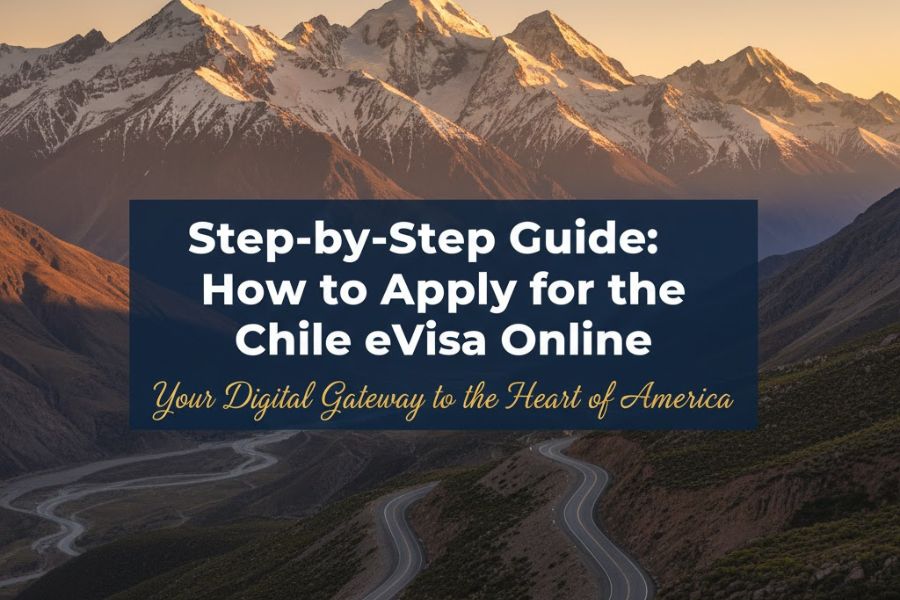
What is the Chile eVisa, and who needs it?
The Chile eVisa is an electronic travel permit that enables the citizens of the qualified countries to travel to Chile on short-term business, family, or tourism trips. The eVisa, unlike the conventional ones, is completely digital, that is, it does not require any paperwork, no lines and no physical appointments.
The travellers should also make sure that they are eligible and possess a valid passport. eVisa usually permits a single entry of up to 90 days, which is suitable when one wants to vacation, attend a conference or take a short trip.
Step 1: Gather All Necessary Documents
Preparation is key. Prior to beginning your Chile eVisa application, you will need:
- A valid passport with at least six months’ validity
- A clear digital passport photograph
- Flight and hotel details
- A valid email address for communication
By being prepared these will save you the inconveniences of making decisions at the last time and help in saving you time by providing your application to be processed in a short time.

Step 2: Fill the application form
The first step to fill out the Chile e-visa application form is to create an account. You will be asked to fill in your personal details very carefully because any mistakes can make your approval slow. When you apply for Chile eVisa, make sure all your information is correct and up to date to avoid delays. Confirm your email in order to activate your account. After activating your account, you can begin the application.
Step 3: Upload Required Documents
Upon filling the form, scan your passport and upload a photograph. Make sure:
- Files are clear and legible
- Photo meets size and format requirements
- Passport details are fully visible
The quality of uploads may decrease the speed of the process, and one should take his time and get everything right.
Step 4: Pay the eVisa Fee Online
Pay the Chile eVisa Fee Online. Make use of a safe means like credit card or debit card. Note down your confirmation of payment, might be needed at some point when you are tracking your application or when you are on boarding a plane.

Step 5: Submit and Track Your Application
When the form and payment has been made, make the application. You will get a confirmation mail with a tracking number. Anytime you can check your status of application online. Processing takes an average of 2-5 days of business, however, it is advisable to apply at least two weeks ahead of your trip.
Step 6: Receive and Prepare Your Chile eVisa
Upon the approval, the Chile eVisa is going to be emailed to you. Print a copy and keep it on your hard disk because airlines might need a hard copy prior to boarding. It is always important to have a digital and printed copy.

Plan Your Travel with Peace of Mind in Chile
Having your Chile eVisa accepted, you will be able to devote all your attention to the exploration of this wonderful country. Chile has a stunning blend of scenery, colorful metropolis and culture. The most effective way is to plan in advance so that you are free of stress, and you can take all the enjoyments. This is a full manual to assist in designing the perfect Chilean experience.
Explore the Urban Wonders
Santiago: The capital city is a perfect blend of modernity and history. Key attractions include:
- Plaza de Armas: The historic center surrounded by colonial buildings.
- Cerro San Cristóbal: Hike or take the funicular to panoramic views of the city and Andes mountains.
- Bellavista & Lastarria: Trendy neighborhoods with art galleries, cafes, and nightlife.
- Museums: Explore Museo de la Memoria y los Derechos Humanos and Chilean National Museum of Fine Arts.
- Culinary Experiences: Sample traditional Chilean dishes at Mercado Central or trendy eateries in Providencia.

Valparaíso: Just a few hours from Santiago, this coastal city is known for:
- Colorful Hills & Murals: Wander the hills to see street art and vibrant houses.
- Historic Funiculars: Ride funiculars connecting lower and upper city neighborhoods.
- Harbor Views: Enjoy boat rides and seafood at local restaurants.
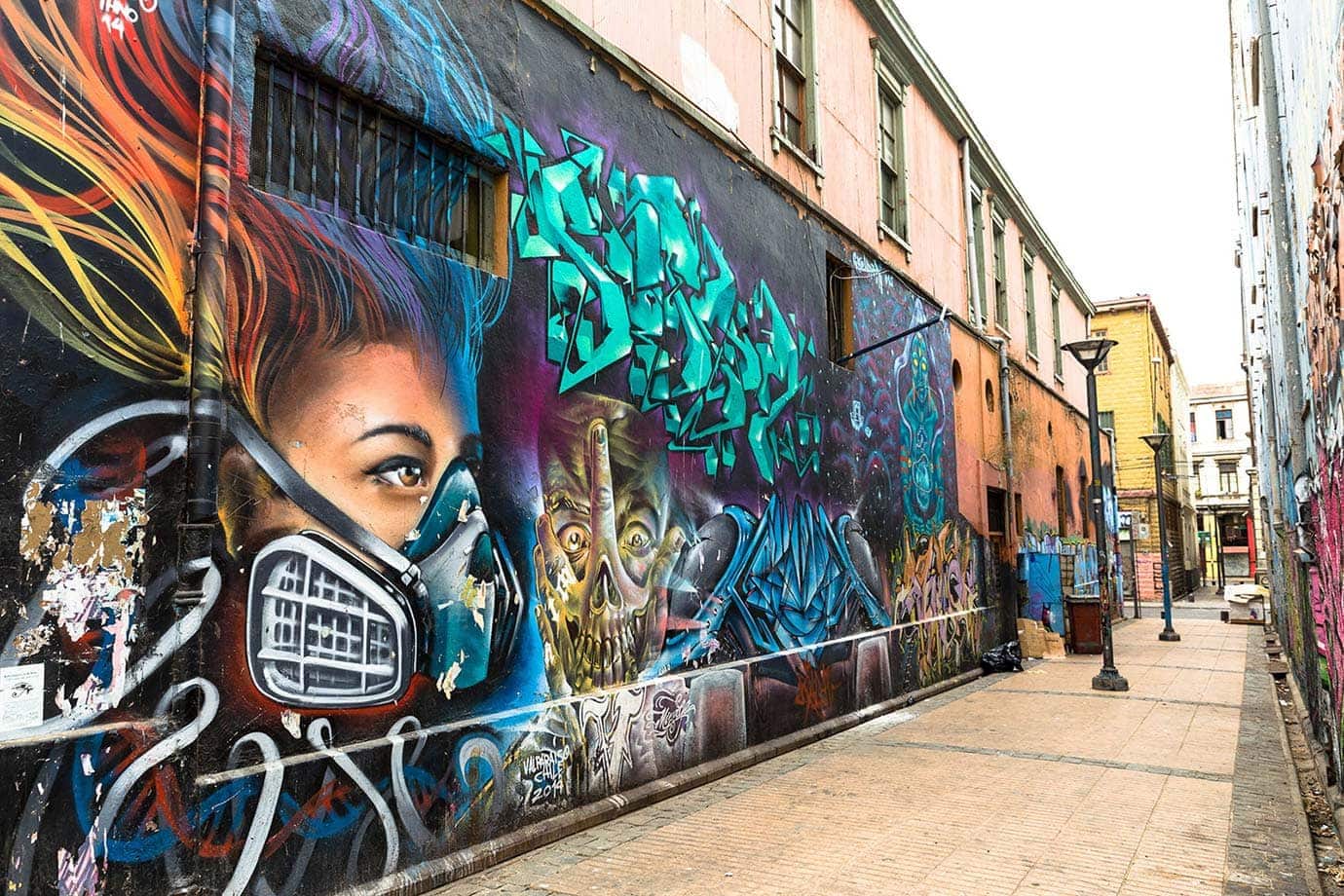
Other Notable Cities:
- La Serena: Beautiful beaches and colonial architecture, perfect for a relaxing coastal stay.
- Concepción: A city with strong cultural life, local markets, and music festivals.
- Puerto Varas: Gateway to the Lake District with German-style architecture and lakeside charm.
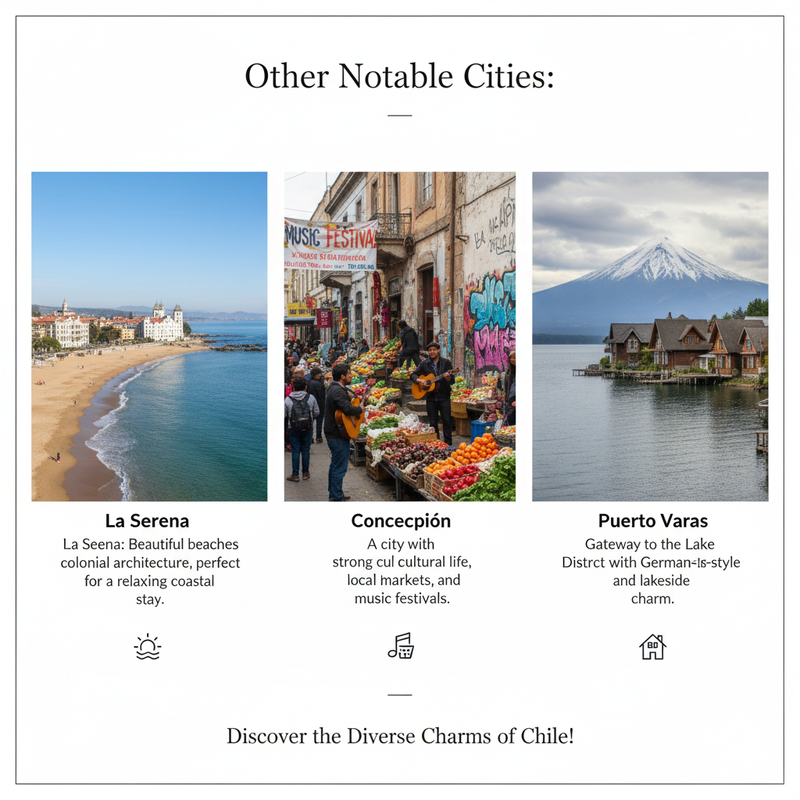
Discover Northern Chile’s Stunning Landscapes
Atacama Desert: One of the driest places on Earth, offering surreal landscapes:
- Valle de la Luna: Unique lunar-like formations and desert sunsets.
- Salar de Atacama: Stunning salt flats teeming with flamingos.
- El Tatio Geysers: Spectacular sunrise views over steaming geysers.
- Lagunas Altiplánicas: High-altitude lagoons surrounded by mountains and wildlife.
Travel Tips:
- Desert temperatures vary drastically; bring layered clothing.
- Stay hydrated and use sunscreen, even in winter.
- Book tours in advance to explore safely with knowledgeable guides.

Southern Chile & Patagonia: Adventure Paradise
Torres del Paine National Park: A dream destination for hikers and photographers:
- Hike iconic trails like the W or O circuits.
- Spot wildlife: guanacos, foxes, condors, and possibly pumas.
- Explore glaciers like Grey Glacier and enjoy boat tours on glacial lakes.

Lake District: Known for lakes, volcanoes, and forests:
- Villarrica Volcano: Hiking and kayaking opportunities.
- Pucon: Adventure hub for rafting, zip-lining, and hot springs.
- Lakes: Llanquihue and Todos los Santos lakes offer boating, fishing, and scenic photography.
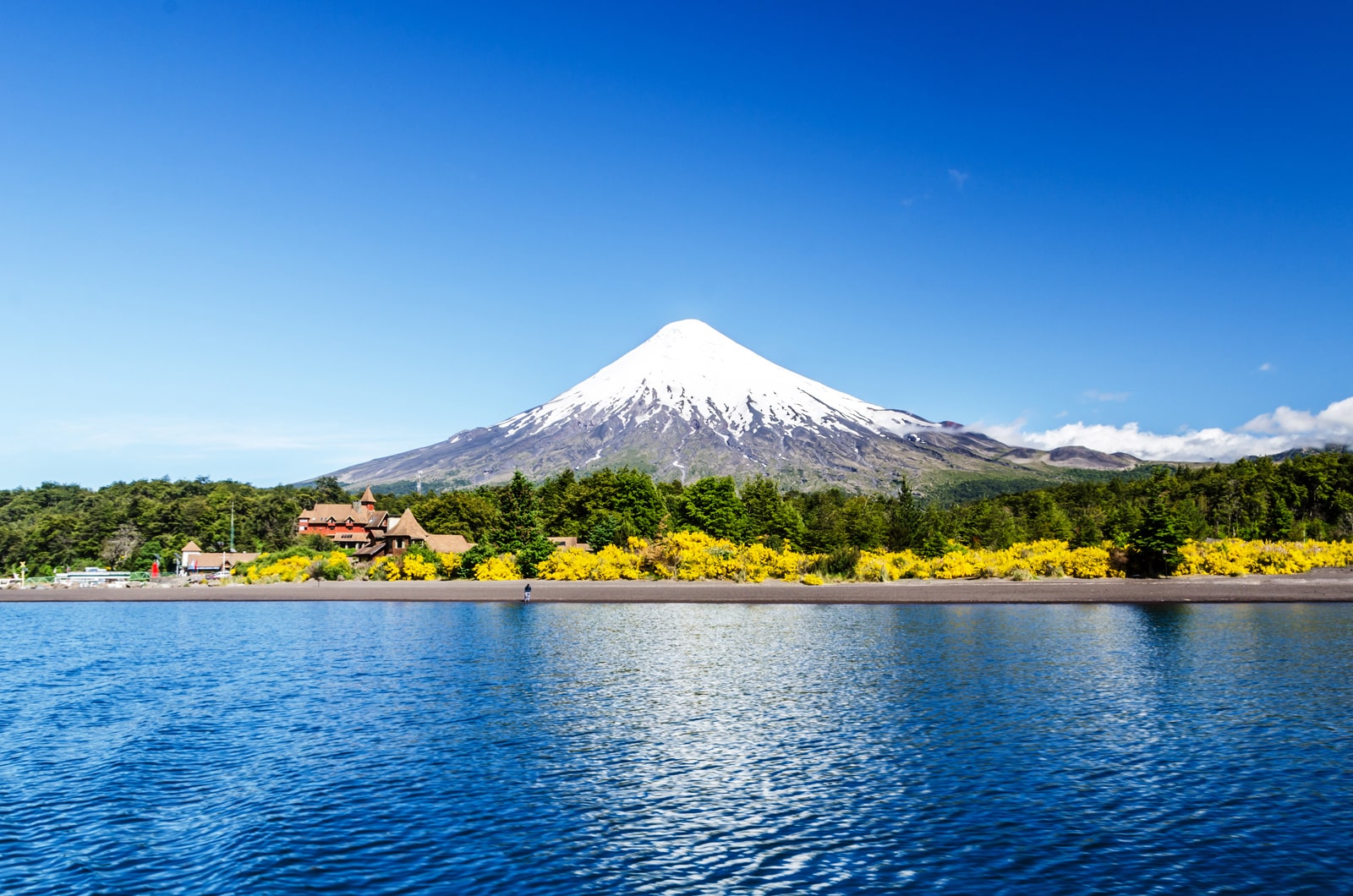
Insider Tips:
- Patagonia weather is unpredictable—always carry waterproof clothing and flexible plans.
- Book accommodation early during peak season (December–March).
Coastal & Island Adventures
Chile’s coastline and islands offer unique experiences:
Chiloé Island:
- Famous for stilt houses (palafitos) and UNESCO-listed wooden churches.
- Rich folklore and local markets selling handcrafted goods.
- Opportunities for kayaking, fishing, and exploring penguin colonies.
Easter Island (Rapa Nui):
- Home to Moai statues and volcanic landscapes.
- Explore caves, archaeological sites, and pristine beaches.
- Learn about the fascinating Polynesian culture and local traditions.
Coastal Towns & Beaches:
- Iquique: Popular for surfing and paragliding.
- La Serena: Relaxing beach towns with calm waters.
- Arica: Warm beaches with strong Pacific waves, ideal for water sports.
Travel Tips:
- Plan island visits in advance; flights and accommodations fill quickly.
- Pack light but include essentials for remote locations.

Culinary Delights to Enhance Your Trip
Chilean cuisine is diverse and region-specific:
- Seafood: Ceviche, machas a la parmesana, fresh fish.
- Traditional Dishes: Empanadas, pastel de choclo (corn pie), cazuela (hearty stew).
- Street Food: Sopaipillas, completos (Chilean hot dogs), and local pastries.
- Wines & Pisco: Chilean wines are globally recognized; consider vineyard tours.
Tip: Visiting local markets gives authentic flavors and cultural immersion while supporting local businesses.

Cultural Experiences & Festivals
Chile offers vibrant festivals and cultural activities:
- Fiestas Patrias (September): National celebrations with food, dance, and parades.
- Carnaval Andino (Northern Chile): Colorful Andean traditions, music, and costumes.
- Patagonian Adventure: Indigenous Mapuche culture experiences in southern regions.
Insider Tip: Check local festival calendars to time your visit for authentic cultural experiences.
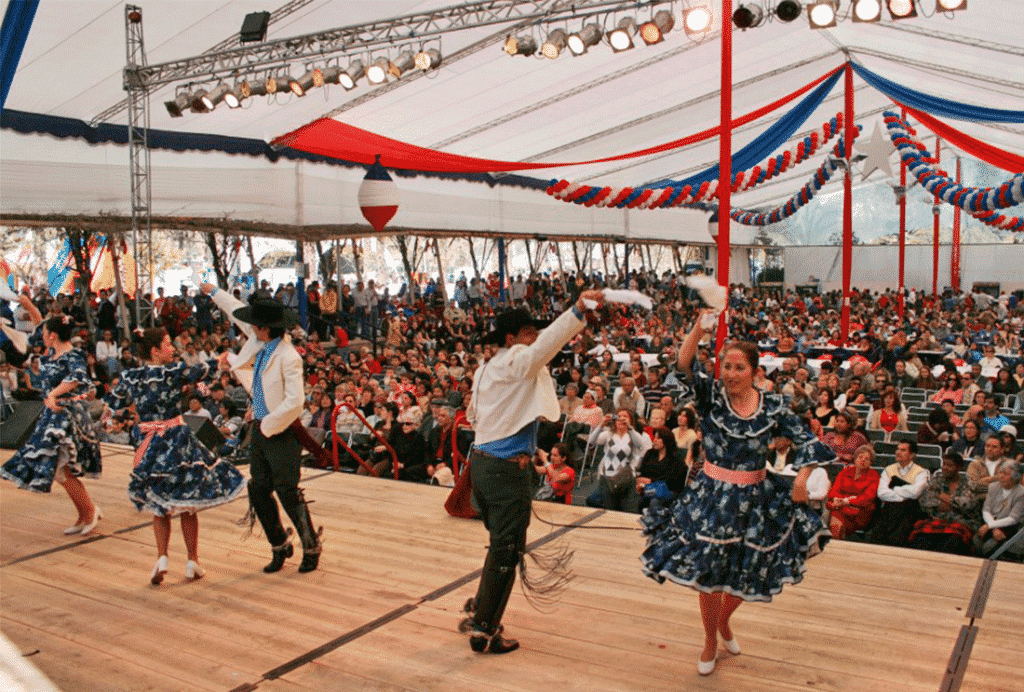
Seasonal & Weather Considerations
Chile’s climate varies drastically:
- Summer (Dec–Feb): Ideal for Patagonia and Lake District.
- Winter (Jun–Aug): Best for skiing in the Andes and Atacama desert experiences.
- Spring & Autumn: Great for mild weather, fewer crowds, and festival experiences.
Tip: Plan outfits according to regional climates—Patagonia is cold year-round, while the north can be hot and dry.

Safety & Peace of Mind
While Chile is generally safe for travelers, follow these tips:
- Keep copies of your eVisa, passport, and emergency contacts.
- Use reliable transportation and avoid isolated areas at night.
- Respect local rules and wildlife regulations, especially in national parks.
- Stay informed about weather, especially in Patagonia and desert regions.
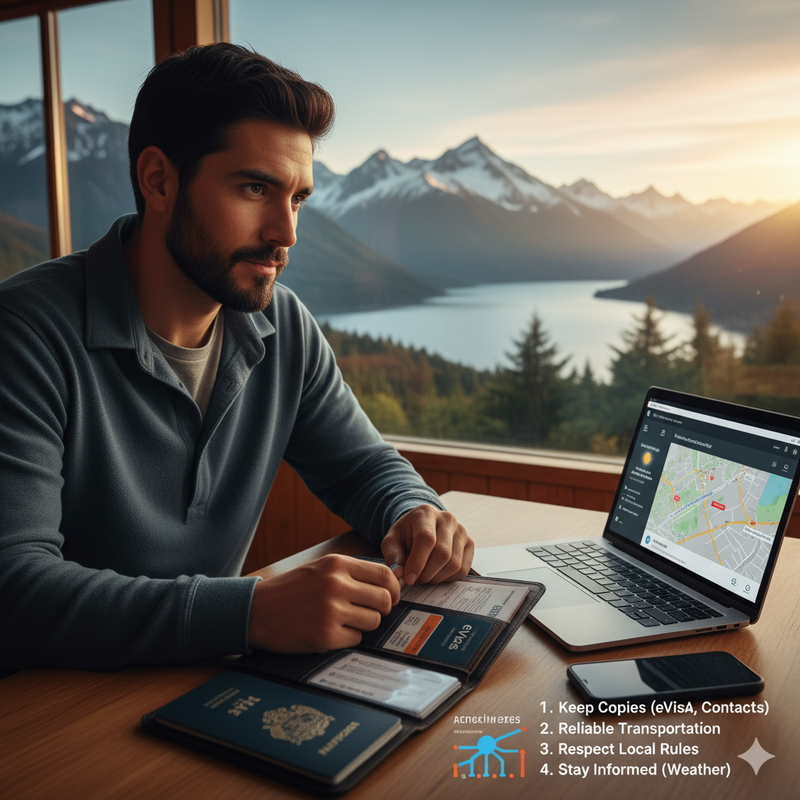
Hidden Gems for Unique Experiences
- Valle del Elqui: Famous for pisco production and stargazing.
- Frutillar: German-influenced town with cultural music festivals.
- Parque Tantauco: Remote Patagonian forest for wildlife spotting and eco-tourism.
- Isla Damas (Near La Serena): Seals, penguins, and quiet beaches.
These lesser-known spots offer immersive experiences away from crowded tourist areas.

Sample 14-Day Chile Itinerary
Day 1-3: Santiago (city tours, wine tasting, Cerro San Cristo Basil)
Day 4-5: Valparaíso and Viña del Mar (sea food, street art, beaches)
Day 6 8: Atacama Desert (valle de la lon, el tatio, stargazing)
Day 9-11: Lake District (Villarrica, Pucon, hikes around the lakes, volcanoes)
Day 12-14: Patagonia (Torres del Paine, glaciers, wildlife, scenic hikes)
Tip: Adjust based on interests—more time in cities, desert, or Patagonia depending on preferences.
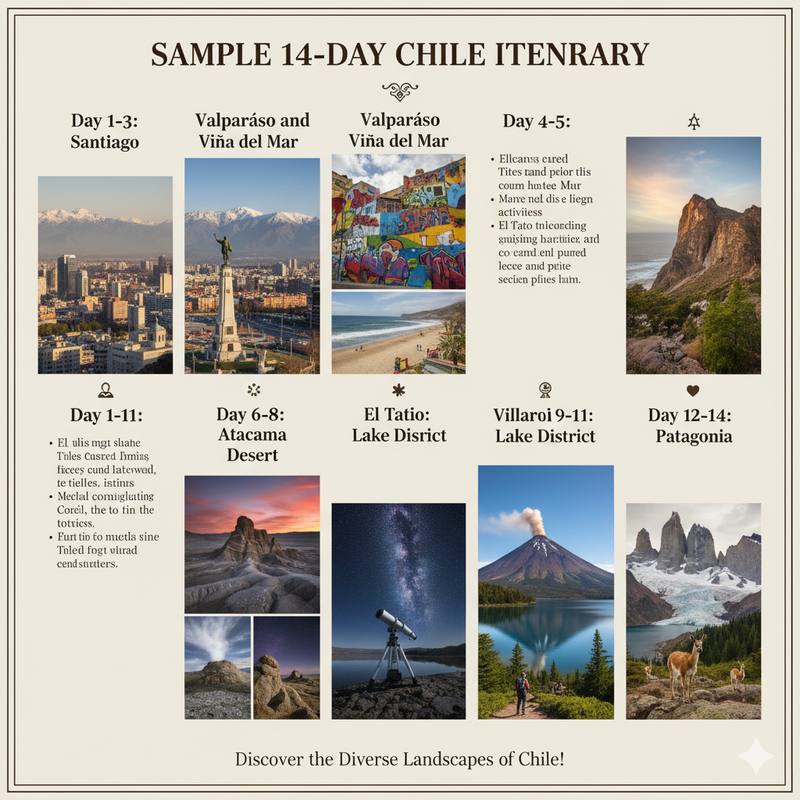
Tips for a Smooth Chile eVisa Experience
- Apply early to avoid last-minute stress
- Ensure all personal and passport details are accurate
- Keep digital backups of all documents
- Review the eVisa type (single-entry or multiple-entry) before travel
Following these tips helps ensure your application is processed without any issues.
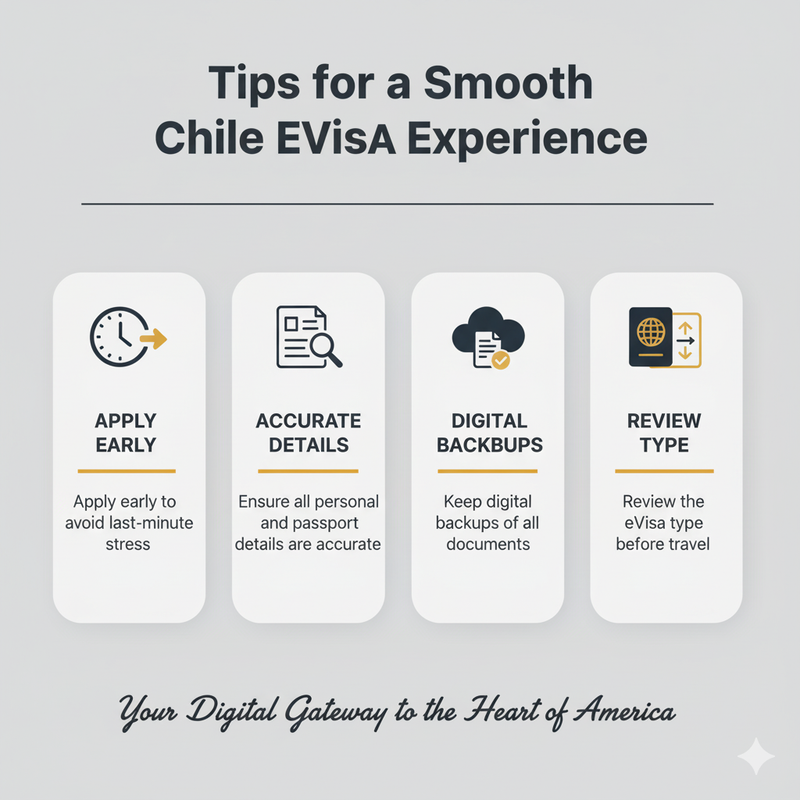
Conclusion
The online Chile eVisa application will unlock one of the most memorable trips of adventure, culture, and nature. With a set of documents ready, completed applications, and with a little bit of preparation and instructions provided in this guide, you can have a smooth and hustle-free process of approval.
You have your eVisa, now it is time to explore all Chile has to offer. Explore the vibrant streets of Valparaíso, take hiking tours through the dramatic mountain-top trails of Patagonia, stare at the stars along the deserts of the Atacama or the Chilean wine-producing valleys of the valleys near Santiago. Traveling with confidence, exploring every part of the region at a comfortable time, and having the ability to build memorable moments are the benefits of proper planning. Having this guide, you are perfectly armed to enjoy your adventure in China because you know that your travel papers are settled and your itinerary is keyed up.
FAQs About Chile eVisa
Q1: Do I have to apply to Chile eVisa any country?
Yes, provided that you have the internet, you can apply anywhere in the world.
Q2: Due time to get Chile eVisa?
The processing of applications normally takes 2-5 working days although it is advisable to apply at least two weeks ahead of time.
Q3: What is the duration of Chile eVisa?
The majority of eVisas permit a single entry of a maximum of 90 days.
Q4: Will I be able to make more than one trip to Chile using a single eVisa?
Majority of Chile eVisas are single entry. Test your visa type in case you will make several visits.
Q5: What would I do in case my eVisa is denied?
There is a chance to apply again, being sure that all information is correct, and documents are readable.
Q6: Is a printed copy necessary?
Yes. Courier services and border guard can also demand a hard copy of the copy other than the digital copy.
Q7: Can I make changes in my application after I have submitted it?
You can do minor corrections on your account before it is approved. Significant modifications can be reapplied.
Q8: How does the use of online versus traditional methods have advantages?
It is time-saving and it does not require queues and is easily tracked using online applications.
Q9: Are there minors allowed to request a Chile eVisa?
Yes, underage people also need their application but the process is the same.
Q10: Am I required to present evidence of funds?
It is not a necessity but it is always good to have travel evidence or accommodation reservations just in case.


